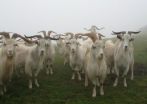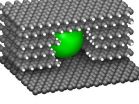(Press-News.org) Amongst the range of domestic livestock species, the goat is not just the 'black sheep' but a resource of survival in impoverished countries, and many breeds are at great risk of disappearing. This is the case according to researchers of the Regional Service of Agro-Food Research and Development in their first monographic study tackling the global impact of this species.
A study from the Regional Service of Agro-Food Research and Development (SERIDA) has analysed the situation of the global goat population.
The study took into account the state of different breeds, the multiple implications of their conservation, the interaction with other animal species (wild and domestic) and the consequences of goat grazing from an environmental point of view.
"The risk of the gene pool of the goat disappearing has increased due to intensive animal husbandry systems that use a very limited number of breeds. Strangely enough, the biggest loss in the genetic resources of indigenous animals has been observed in Europe, although the situation is unknown in many areas," as explained to SINC by Rocío Rosa García, researcher at SERIDA and coauthor of the study.
The bad reputation given to goats stems from one of its main virtues: it has an extraordinary capacity to adapt to the most difficult of environmental conditions in places where other domestic livestock species would not survive.
"It is a reality that the grazing of these animals can cause damaging effects on the environment but ecosystems become overloaded because of inadequate practices of handling," ensures the scientist.
According to data from the Food and Agriculture Organisation of the United Nations (FAO), nowadays the largest number of goats can be found in the poorest of countries and especially those which have difficult environmental conditions and mountainous, desert and semi-desert regions.
"In poor regions, poor communities are commonplace and often the goat is the only source of animal protein in their diet," explains Rosa García.
The team led by Koldo Osoro Otaduy, manager of the Animal Production Systems Area at SERIDA and centre director, undertook a large part of the field work in areas in which the role of the goat is very relevant and have certain similarities with hostile environments in other parts of the world.
"Many national and international projects have been carried out in less-favoured areas, like the Asturian mountains which are home to steep slopes, poor soil, an aging population and a high risk of depopulation and abandonment of traditional activities," ensure the researchers.
The goat: its virtues and defects
Poor handling of grazing, which does not consider the livestock species and their most fitting habitat, is the main cause of the damaging effects that goats can cause on the environment.
For example, the uncontrolled growth of the cashmere goat to increase production of its prized wool has meant in some cases that the ecosystems have become overloaded. This has not only affected vegetation but also certain indigenous species in India, China and Mongolia.
To counteract this, the study also considers a large number of cases in which the species plays an important role in environmental conservation. These include their use in the fight against fires in areas dominated by bushes and in controlling exotic vegetation plagues that could put ecosystems at risk.
"We wanted to perform a global review, taking into account very different regions of the world, from the Himalayan peaks to tropical areas, and analysing to what extent the goat competes with local fauna in each region and whether it interferes with the survival of the most sensitive species," outlines Rosa García.
INFORMATION:
References:
R. Rosa Garcia, R. Celaya, U. Garcia, K. Osoro. "Goat grazing, its interactions with other herbivores and biodiversity conservation issues" Small Ruminant Research 107 (2012) 49– 64.
The global gene pool of the goat is seriously under threat
2013-01-23
ELSE PRESS RELEASES FROM THIS DATE:
How the purple and pink sunscreens of reef corals work
2013-01-23
New research by the University of Southampton has found a mechanism as to how corals use their pink and purple hues as sunscreen to protect them against harmful sunlight.
Many reef corals need light to survive, as they benefit from sugars and lipids that are produced by their light-dependent symbiotic algae. However, in the shallow water of coral reefs, light levels are often higher than required by the corals, so paradoxically, the vital sunlight can become harmful for the algae and their hosts.
Apart from temperature, light stress is a major driver of coral bleaching ...
Santiago, Chile, will get drier and warmer
2013-01-23
This press release is available in German and Spanish.
Santiago de Chile/Leipzig. Already nowadays ten per cent or more of the population in the Metropolitan Region of Santiago de Chile is affected by extreme heat or floods. These threats will tend to increase due to the continuous expansion of the Chilean capital, the consequent changes in land use and the influences of climate change. Because of that, the international research project ClimateAdaptationSantiago (CAS) has developed, during the last three years, an Adaptation Plan to climate change for the metropolitan ...
Breakthrough: How salt stops plant growth
2013-01-23
Washington, D.C. —Until now it has not been clear how salt, a scourge to agriculture, halts the growth of the plant-root system. A team of researchers, led by the Carnegie Institution's José Dinneny and Lina Duan, found that not all types of roots are equally inhibited. They discovered that an inner layer of tissue in the branching roots that anchor the plant is sensitive to salt and activates a stress hormone, which stops root growth. The study, published in the current issue of The Plant Cell, is a boon for understanding the stress response and for developing salt-resistant ...
Reinventing retirement: New pathways, new arrangements, new meanings
2013-01-23
Retirement involves a set of institutional arrangements combined with socio-cultural meanings to sustain a distinct retirement phase in life course and career pathways. The articles outline that recent forces of change may lead to reinvention of retirement. There are factors that must be recognized as having a significant impact such as the fact that life expectancy and health status of adults over 60 has increased dramatically in recent years. Reinvention could involve change to one or more of the institutional arrangements supporting retirement. New financial risks and ...
Nanoparticles digging the world's smallest tunnels
2013-01-23
This press release is available in German.
The world's smallest tunnels have a width of a few nanometers only. Researchers from Karlsruhe Institute of Technology (KIT) and Rice University, USA, have dug such tunnels into graphite samples. This will allow structuring of the interior of materials through self-organization in the nanometer range and tailoring of nanoporous graphite for applications in medicine and battery technology. Results are now presented in the scientific journal Nature Communications (DOI: 10.1038/ncomms2399).
The tunnels are manufactured applying ...
Researchers create self-healing, stretchable wires using liquid metal
2013-01-23
Researchers from North Carolina State University have developed elastic, self-healing wires in which both the liquid-metal core and the polymer sheath reconnect at the molecular level after being severed.
"Because we're using liquid metal, these wires have excellent conductive properties," says Dr. Michael Dickey, an assistant professor of chemical and biomolecular engineering at NC State and co-author of a paper on the work. "And because the wires are also elastic and self-healing, they have a lot of potential for use in technologies that could be exposed to high-stress ...
Learn to be more understanding by watching The Bachelor (this season, anyway)
2013-01-23
A new USC study finds evidence suggesting that the brain works hard to understand those who have different bodies when watching them in action.
According to the study's lead author, the finding supports initiatives to include more individuals with physical differences in mainstream media – such as Sarah Herron, a contestant on ABC's The Bachelor this season, who was born with a foreshortened left arm.
"Generally, it's considered impolite to stare. But what these results suggest is that we need to look. It's through this visual experience that we're able to make sense ...
New way to identify 'smoked' grapes and wines
2013-01-23
With climate change sparking concern about an increased risk of wildfires, scientists are reporting development of a way to detect grapes exposed to smoke from those fires, which otherwise could be vented into bad-tasting wine. Their report on the method for detecting smoke taint in both grapes and wine appears in ACS' Journal of Agricultural and Food Chemistry.
Yoji Hayasaka and colleagues point out that Australia and other areas of the world are experiencing an increase in bush and wildfires, which may continue and intensify with global climate change. Smoke from those ...
Scientists underestimated potential for Tohoku quake. Now what?
2013-01-23
CORVALLIS, Ore. – The massive Tohoku, Japan, earthquake in 2011 and Sumatra-Andaman superquake in 2004 stunned scientists because neither region was thought to be capable of producing a megathrust earthquake with a magnitude exceeding 8.4.
Now earthquake scientists are going back to the proverbial drawing board and admitting that existing predictive models looking at maximum earthquake size are no longer valid.
In a new analysis published in the journal Seismological Research Letters, a team of scientists led by Oregon State University's Chris Goldfinger describes how ...
Putting the squeeze on cells
2013-01-23
CAMBRIDGE, Mass. — Living cells are surrounded by a membrane that tightly regulates what gets in and out of the cell. This barrier is necessary for cells to control their internal environment, but it makes it more difficult for scientists to deliver large molecules such as nanoparticles for imaging, or proteins that can reprogram them into pluripotent stem cells.
Researchers from MIT have now found a safe and efficient way to get large molecules through the cell membrane, by squeezing the cells through a narrow constriction that opens up tiny, temporary holes in the membrane. ...





